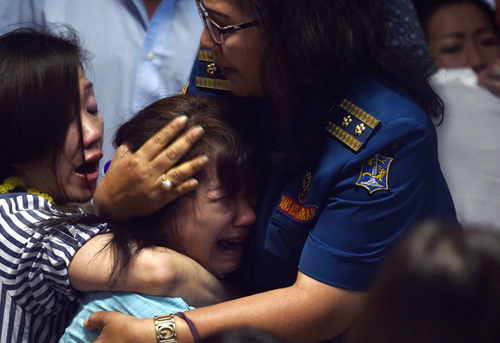Jakarta/Singapore, Dec 30: After three days of intense search, at least 40 bloated bodies and debris of the missing AirAsia aircraft carrying 162 people were found today in the Java Sea off Indonesia but mystery remained over the cause of the crash.
The Indonesian navy reported that 40 bodies had been retrieved by one warship and rescuers were continuing to recover more bodies and were "very busy now".

The debris of the missing AirAsia plane along with floating bodies of some of the 162 people on board were spotted today in the Java Sea off Indonesia, close to the area where contact was lost with the aircraft on Sunday morning.
Indonesian Transportation Ministry's acting director general of air transportation, Djoko Murjatmodjo, confirmed that that wreckage discovered in Pangkalan Bun, Central Kalimantan, was from AirAsia flight QZ8501.
"It has been confirmed that it is debris from an aircraft bearing red and white colours," Djoko said, citing that the debris was found by the ministry's rescue team.
"The recovery process will now be centered in the debris location in coordination with Basarnas (the National Search and Rescue Agency)," he said.
Later, an air force plane spotted a "shadow" on the seabed believed to be that of the Airbus A320-200, Indonesia's National Search and Rescue Agency chief Bambang Soelistyo told reporters.
"God blessed us today. At 12:50 the air force Hercules found an object described as a shadow at the bottom of the sea in the form of a plane," he said.
Indonesian officials said they recovered several bodies floating in waters near the area where the missing plane was last seen.
The bodies were bloated but intact and were brought to an Indonesian navy ship, National Search and Rescue Director S B Supriyadi told reporters in Pangkalan Bun.
Navy spokesman Manahan Simorangkir confirmed the discovery to a TV station but did not comment on whether they were dead or alive.
National Search and Rescue Agency spokesman M Yusuf Latif said that a maritime patrol aircraft from the Indonesian Air Force first discovered the debris during a search.
Ten pieces of debris were found during the search for the ill-fated AirAsia Indonesia aircraft southwest of Pangkalan Bun in Central Kalimantan.
"We just searched (the location) until 11 am. So, according to estimations, the debris was seen at 10:15 am (local time)," Yusuf told reporters. The location of the debris matched information from two fishermen in Pangkalan Bun who said that they heard a thud and saw explosions on Sunday morning, he was quoted as saying by the Jakarta Post.
After the discovery was made, the Indonesian agency immediately dispatched a chopper to the location. "We are ordering two members of the Basarnas team to retrieve the debris using hoists," Yusuf said.
The Airbus A320-200 was carrying 155 passengers -- one British, one Malaysian, one Singaporean, three South Koreans, 149 Indonesians -- and seven crew members -- six Indonesians and a French co-pilot.
Seventeen of the passengers were children. There were no Indian nationals on board.
During a news conference by the head of the operation, shown live on Indonesian TV, pictures of the debris were shown including a body floating on the water. Relatives of passengers on the plane watching the pictures were visibly shocked.
AirAsia CEO Tony Fernandes, who is an ethnic Indian, tweeted to the families: "My heart is filled with sadness for all the families involved in QZ 8501. On behalf of AirAsia my condolences."
All resources were now being sent to the area where the debris was found, and all objects or bodies found would be taken to Pangkalan Bun, Soelistyo said, referring to a nearby town in Central Kalimantan province.
Soelistyo said that ships with more sophisticated technology were being deployed to check whether larger parts of the plane were submerged beneath the debris.
At least 30 ships, 15 aircraft and seven helicopters had joined the search for the AirAsia flight that went missing on Sunday morning after taking off from Surabaya in eastern Java on its way to Singapore.
The multinational operation, led by Indonesia, was joined by Malaysia, Singapore and Australia, with other offers for help from countries like India, South Korea, China and France. The US destroyer USS Sampson was also on its way to the zone as the discovery was found.
Earlier, several sightings, including something that resembled oil spill east of Belitung island, turned out to be false alarms.
The search by Indonesian Air Force planes spotted two pools of possible oil slick yesterday but these were later determined to be shadows from underwater coral.
The search area, originally divided into seven sectors, was today expanded to 13, covering air, sea and land.





Comments
Add new comment